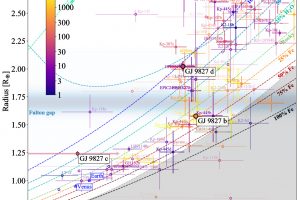Three super-Earth for a star. The study “Masses and radii for the three super-Earths orbiting GJ 9827, and implications for the composition of small exoplanets” of K. Rice (University of Edinburgh) published by MNRAS

Super-Earths are exoplanets with radii between that of the Earth and that of Neptune (about 4 times the radius of the Earth), and with orbital periods smaller than 100 days. Although the Solar System does not host a similar planet, super-Earths are actually common in the Milky Way. This type of exoplanet is also interesting since they populate a gap in the distribution of exoplanet radii which may reveal important information about the formation and early evolution of exoplanets.
Planets with a radius smaller than 1.5 Earth radii appear to be predominantly rocky, with a weak, or no, atmosphere, while planets with a radius larger than 2 Earth radii typically maintain a substantial atmosphere. These two evolutionary pathways probably depends on how the planet was irradiated during its formation and early evolution. Energetic radiation (UV and X-rays) from the central star can heat the gas up to temperatures of about a thousand degrees, causing it evaporate (photoevaporation). Planets that have been heavily irradiated by UV and X-ray photons, may have lost their atmospheres and may then populate the family of small rocky planets, while planets that formed in low-irradiation environments may have kept their atmospheres and now populate the family that retain substantial atmospheres.
For this reason, the study of super-Earths is important. The international team led by K. Rice (University of Edinburgh), counting also the astronomers G. Micela and L. Affer of INAF – Astronomical Observatory of Palermo, has studied the exoplanetary system orbiting the star GJ 9827 (which has a mass of 0.6 solar masses and a temperature of 4300 degrees), already known to host three super-Earths. The authors have analyzed the light curve (variations in the emitted stellar flux with time) obtained with the NASA satellite Kepler, and 43 spectroscopic observations acquired with HARPS-N at the Telescopio Nazionale Galileo (TNG). They have found that GJ 9827 b is a planet with a radius of 1.6 Earth radii and an orbital period of 1.2 days, GJ 9827 c is 1.2 Earth radii with an orbital period of 3.6 days, and GJ 9827 d is 2.0 Earth radii with an orbital period of 6.2 days. In addition, the masses of planets b and d are very similar (4.9 and 4.0 Earth masses, respectively), while the mass of planet c is not well constrained. The resulting composition analysis indicates that GJ 9827 b is likely a rocky planet with an iron-rich core, while GJ 9827 d has a gaseous-rich atmosphere. The planetary system orbiting GJ 9827 is thus particularly interesting, hosting three super-Earth, two of which have similar masses, but different compositions. That these two planets sit on either side of the gap in the exoplanet radius distribution can thus provide important information about the formation and evolution of such a class of exoplanets. The results of the study are published by the Monthly Notices of the Royal Academic Society in the paper “Masses and radii for the three super-Earths orbiting GJ 9827, and implications for the composition of small exoplanets“.
The figure (link) shows the mass vs. radius distribution of the planets orbiting GJ 9827, and all exoplanets with mass estimates in the Extrasolar Planets Encyclopaedia
by Mario Giuseppe Guarcello ( follow mguarce)
